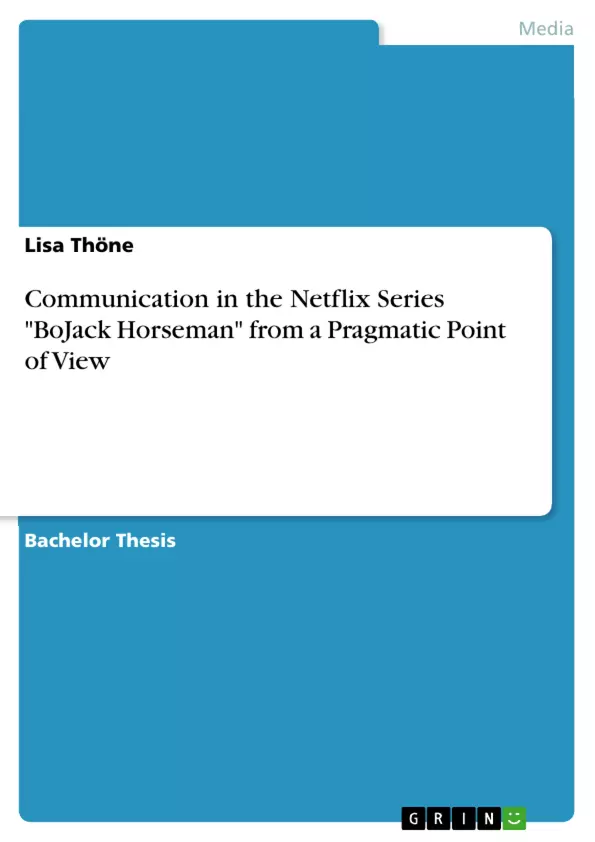This Bachelor Thesis combines insights from Pragmatics, Media and Communication Studies, and Popular Culture. The thesis analyses in how far Bojack Horseman, protagonist in the Netflix series "Bojack Horseman", fulfills politeness principles and felicity conditions to communicate successfully with different interlocutors. It effectively illustrates how Bojack's communication evolves throughout the seasons.
The paper begins by briefly defining some relevant concepts that are essential for the understanding of the series "BoJack Horseman" as well as the linguistic analysis of it. After this, some previous research on the series in focus is outlined to give an insight into possible research areas for this series and the relevance of the series in general. Subsequently, the working hypothesis presumes the approximate outcome of the analysis. As a last part of the Background/Theory Chapter, the different pragmatic theories which build the basis for the analysis are displayed and discussed in detail. As a first step of the analysis part, the data at hand, as well as the conducted methodology, are presented. Next, BoJack’s communication with his closest friends is analysed, based on the explicated theories, to then move on to discuss his communication in public. The results of the analysis are presented during 3.2 and 3.3. Nonetheless, an overview of the results is given in 3.4. To finish the research, the discussion and conclusion part delivers an overview of all findings and their implications for linguistics as well as other areas, which are also discussed broadly.
Inhaltsverzeichnis (Table of Contents)
- 1. Introduction
- 2. Background/Theory Chapter
- 2.1 Defining some Concepts
- 2.2 Previous Research on BoJack Horseman
- 2.3 Working Hypothesis
- 2.4 Theories
- 3. Analysis
- 3.1 Data and Methodology
- 3.2 BoJack's Communication with his Closest Friends
- 3.3 BoJack's Communication in Public
- 3.4 Results - An Overview
- 4. Discussion/Conclusion
- 5. Works Cited
Zielsetzung und Themenschwerpunkte (Objectives and Key Themes)
This thesis aims to analyze the communication strategies of the main character BoJack Horseman in the Netflix series of the same name, from a pragmatic point of view. By focusing on BoJack's interactions with his close friends and the public, the analysis will demonstrate how his use of speech acts, adherence to communicative principles, and interpretation of situations contribute to his often-unsuccessful communication.- Analyzing the impact of BoJack's communication strategies on his relationships with his closest friends.
- Exploring the dynamics of BoJack's communication in public settings and how it is perceived by both himself and others.
- Evaluating BoJack's communication through the lens of pragmatic theories, such as speech act theory, the cooperative principle, and the politeness principle.
- Examining the interplay of comedy, drama, and animation in shaping the character's communication and its reception by the audience.
- Assessing BoJack's ability to navigate and re-establish relationships despite his communication challenges.
Zusammenfassung der Kapitel (Chapter Summaries)
- Introduction: This chapter introduces BoJack Horseman as a complex character struggling with his emotions and relationships. It highlights the balance of comedy and darkness in the series and sets the stage for the pragmatic analysis of BoJack's communication.
- Background/Theory Chapter: This chapter provides definitions of key concepts like speech acts, politeness, and the elements of drama, comedy, and animation. It also reviews existing research on BoJack Horseman and introduces the working hypothesis of the thesis.
- Analysis: This chapter delves into the core analysis of BoJack's communication, focusing on his interactions with his closest friends and his communication in public settings. It applies pragmatic theories to understand the nuances of his speech acts and their impact on his relationships.
Schlüsselwörter (Keywords)
This thesis explores the communication strategies of the main character BoJack Horseman in the Netflix series BoJack Horseman, utilizing a pragmatic approach. Key concepts include speech act theory, the cooperative principle, and the politeness principle, as well as the interplay of comedy, drama, and animation. The research examines BoJack's communication with his friends and in public, revealing insights into the complexities of human interaction and the challenges of navigating personal and social relationships.- Citation du texte
- Lisa Thöne (Auteur), 2021, Communication in the Netflix Series "BoJack Horseman" from a Pragmatic Point of View, Munich, GRIN Verlag, https://www.grin.com/document/1474649



